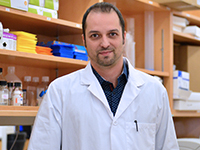World AIDS Day: ImPaKT makes an impact
The Imaging Pathogens for Knowledge Translation (ImPaKT) facility at Schulich Medicine & Dentistry is nearing completion. The state-of-the-art facility will enhance researchers' ability to study how HIV acts on the body, and to bolster research in the area of vaccine development. We asked four top HIV/AIDS researchers what impact the ImPaKT facility will have on their research programs.
Jessica Prodger, PhD
 "Not all sexual exposures to HIV result in infection, and the risk varies greatly between individuals. Understanding what makes someone less susceptible to HIV will help us develop better prevention strategies. Our group has recently discovered that certain aspects of the penile 'microbiome' – the normal community of microbes living on the penis – can make a man more or less susceptible to HIV. The Imaging Pathogens for Knowledge Translation (ImPaKT) Facility will allow us to follow fluorescently tagged HIV particles, and see how microbes affect the virus’s ability to infect penile tissue. We plan to use this knowledge to create targeted antimicrobials for protection against HIV."
"Not all sexual exposures to HIV result in infection, and the risk varies greatly between individuals. Understanding what makes someone less susceptible to HIV will help us develop better prevention strategies. Our group has recently discovered that certain aspects of the penile 'microbiome' – the normal community of microbes living on the penis – can make a man more or less susceptible to HIV. The Imaging Pathogens for Knowledge Translation (ImPaKT) Facility will allow us to follow fluorescently tagged HIV particles, and see how microbes affect the virus’s ability to infect penile tissue. We plan to use this knowledge to create targeted antimicrobials for protection against HIV."
Eric Arts, PhD
 "Infectious diseases remain the leading cause of mortality around the world, often targeting vulnerable populations. The Imaging Pathogens for Knowledge Translation (ImPaKT) Facility will enhance our ability to make important discoveries in biomedical imaging and pathogen biology, and will advance a paradigm shift in pathogen research and related drug/vaccine development. ImPaKT will permit real-time tracking of infectious agents and monitoring immune responses simultaneously in live animals, by integrating cutting-edge infectious disease research with whole animal multi-modality molecular imaging including positron emission tomography (PET), magnetic resonance imaging (MRI), optical/computerized tomography (CT), multispectral optoacoustic tomographic imaging (MSOTi) and intravital multiphoton microscopy."
"Infectious diseases remain the leading cause of mortality around the world, often targeting vulnerable populations. The Imaging Pathogens for Knowledge Translation (ImPaKT) Facility will enhance our ability to make important discoveries in biomedical imaging and pathogen biology, and will advance a paradigm shift in pathogen research and related drug/vaccine development. ImPaKT will permit real-time tracking of infectious agents and monitoring immune responses simultaneously in live animals, by integrating cutting-edge infectious disease research with whole animal multi-modality molecular imaging including positron emission tomography (PET), magnetic resonance imaging (MRI), optical/computerized tomography (CT), multispectral optoacoustic tomographic imaging (MSOTi) and intravital multiphoton microscopy."
Jamie Mann, PhD
 "Understanding the mechanisms and requirements for priming of immune responses is critical in the development of vaccines and therapies against viruses such as HIV. This Imaging Pathogens for Knowledge Translation (ImPaKT) Facility will enable scientists like myself to see static and dynamic cellular interactions occurring within the various tissues of the body. This will allow us to better understand their complex interplay in response to vaccination and infection. The ImPaKT Facility at the Schulich School of Medicine & Dentistry will be the only one of its kind in Canada that will combine sophisticated imaging technology with a world-class biosafety facility."
"Understanding the mechanisms and requirements for priming of immune responses is critical in the development of vaccines and therapies against viruses such as HIV. This Imaging Pathogens for Knowledge Translation (ImPaKT) Facility will enable scientists like myself to see static and dynamic cellular interactions occurring within the various tissues of the body. This will allow us to better understand their complex interplay in response to vaccination and infection. The ImPaKT Facility at the Schulich School of Medicine & Dentistry will be the only one of its kind in Canada that will combine sophisticated imaging technology with a world-class biosafety facility."
Greg Dekaban, PhD
 "In order for cell-based vaccines or immunotherapies to be effective and achieve the desired immune response, it’s required that the cells carrying the vaccine go to immune tissues (lymph nodes and spleen). It is also critical for immune cell therapy safety that the cell-based vaccine or immunotherapy reach its intended target immune tissue and not off-tissues where toxic effects can occur. Also key to cell-based vaccine and immunotherapy effectiveness, is that cell-based vaccines must reach and persist in their intended target tissue in sufficient numbers to induce the desired immune response. It’s important for clinicians to be able to non-invasively and in real time track injected vaccines, so they can provide personalized patient assessments, and provide real-time modifications if necessary. The Imaging Pathogens for Knowledge Translation Facility will provide researchers the environment to develop methods for the critical non-invasive, real time tracking of injected therapeutic cells using cellular magnetic resonance imaging techniques."
"In order for cell-based vaccines or immunotherapies to be effective and achieve the desired immune response, it’s required that the cells carrying the vaccine go to immune tissues (lymph nodes and spleen). It is also critical for immune cell therapy safety that the cell-based vaccine or immunotherapy reach its intended target immune tissue and not off-tissues where toxic effects can occur. Also key to cell-based vaccine and immunotherapy effectiveness, is that cell-based vaccines must reach and persist in their intended target tissue in sufficient numbers to induce the desired immune response. It’s important for clinicians to be able to non-invasively and in real time track injected vaccines, so they can provide personalized patient assessments, and provide real-time modifications if necessary. The Imaging Pathogens for Knowledge Translation Facility will provide researchers the environment to develop methods for the critical non-invasive, real time tracking of injected therapeutic cells using cellular magnetic resonance imaging techniques."








